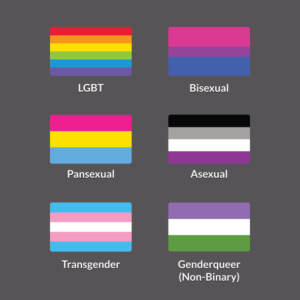Pride Flags 101: A Quick Guide

It’s a common tendency among humans to create or co-opt symbols to represent themselves or their larger communities. LGBTQ individuals are no different, crafting emblems and logos infused with deeper meanings. Some of these symbols, particularly pride flags, have been recreated in various iterations to represent the communities and identities falling under the LGBTQ umbrella.
A History of the Original Rainbow Flag
In the 1970s, San Francisco saw increased LGBTQ political activity and community building. “Gay-ins” eventually transformed into the Gay Liberation Day Parade, which in turn became San Francisco Pride. Meanwhile, more LGBTQ nightclubs, community centers and groups formed. In 1977, Harvey Milk became the first openly gay individual elected to public office in the city. Responding to a challenge issued to him by Milk, artist Gilbert Baker created the first rainbow flag for the city’s 1978 Pride parade. New York’s Museum of Modern Art acquired a version of the now-iconic flag for its design collection in 2015. They also published an interview of Baker describing the banner’s genesis.
Today’s version contains red, orange, yellow, green, blue, and violet stripes. Baker’s original used these plus a hot pink and a turquoise stripe and indigo instead of blue. Baker removed both pink and turquoise from subsequent designs because of fabric availability issues. He was also concerned about the cost of printing multiple colors on photographs at the time. A new edition of the rainbow pride flag was introduced in 2017 for Philadelphia’s Pride events. It added black and brown to the six standard colors, plus the blue, white, and pink from the transgender flag.
Other Banners Break the Binary
In addition to the original rainbow flag, several dozen iterations have been designed to represent other groups in the LGBTQ community. One of the first was the transgender pride flag, designed in 1999 by a trans woman activist named Monica Helms. In a 2017 article for Logo, Samantha Manzella writes that the trans pride banner debuted at the Phoenix Pride parade in 2000. Helms explained that her flag has two blue stripes, two pink stripes and a white stripe in the center to represent trans men and women. She also intended it to represent intersex individuals, those transitioning, and others who feel they do not have a gender.
Manzella also lists other flags designed for communities of people who do not identify as the genders they were assigned at birth:
- The intersex pride flag, displaying a purple circle on a yellow field
- The nonbinary pride flag, which uses yellow, black, purple and white
- The agender pride flag, which has white, black, gray and mint-green stripes
These pride flags were created in the early 2010s and, like the trans pride and rainbow flags, each set of colors has its own significance.
Beyond Simply “Gay” or “Lesbian”
Communities of people who identify as bisexual, pansexual and asexual have also crafted their own pride flags. A 2013 Huffington Post piece tells the story of Gigi Raven Wilbur, Wendy Curry and Michael Page. These three individuals invented “Celebrate Bisexuality Day”. Page designed the bisexual pride flag in 1998. It was created because he found a lack of meaningful symbols for bisexual people in the LGBTQ community. Page describes his banner as having three colors: pink to represent same-sex attraction, blue to stand for opposite-gender desire and purple to blend the two. Other pride flags include a flag for pansexual folk, who can desire people of any gender, and asexual individuals, who do not experience romantic or sexual attraction at all.
More Than Just a Rainbow
The original 1978 version of the rainbow flag may have been just the beginning. In the four decades since that first iteration, communities under the LGBTQ umbrella have forged their own flags and signs. These banners are just one of many steps in hopefully achieving broader visual representation and recognition.














